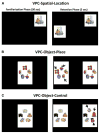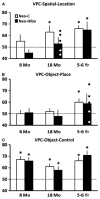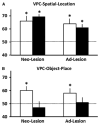Development of memory for spatial locations and object/place associations in infant rhesus macaques with and without neonatal hippocampal lesions
- PMID: 23880255
- PMCID: PMC4112569
- DOI: 10.1017/S1355617713000799
Development of memory for spatial locations and object/place associations in infant rhesus macaques with and without neonatal hippocampal lesions
Abstract
This study traces the development of spatial memory abilities in monkeys and reports the effects of selective neonatal hippocampal lesions on performance across development. Two different versions of the visual paired-comparison (VPC) task were used. The VPC-Spatial-Location task tested memory for object-locations that could be solved using an egocentric spatial frame of reference and the VPC-Object-In-Place task taxed memory for spatial relations using an allocentric reference frame. Eleven rhesus macaques (6 neonatal sham-operated controls and 5 with neonatal neurotoxic hippocampal lesions) were tested on both tasks as infants (8 months), juveniles (18 months), and adults (5-6 years). Memory for spatial locations was present by 18 months of age, whereas memory for object-place relations was present only in adulthood. Also, neonatal hippocampal lesions delayed the emergence of memory for spatial locations and abolished memory for object-place associations, particularly in animals that had sustained extensive and bilateral hippocampal lesions. The differential developmental time course of spatial memory functions and of the effects of neonatal hippocampal lesions on these functions are discussed in relation to morphological maturation of the medial temporal lobe structures in monkeys. Implications of the findings for the neural basis of spatial memory development in humans are also considered.
Conflict of interest statement
We acknowledge that none of the authors have a conflict of interest with the publication of this manuscript.
Figures




Similar articles
-
Developmental trajectory of object recognition memory in infant rhesus macaques with and without neonatal hippocampal lesions.J Neurosci. 2010 Jul 7;30(27):9157-65. doi: 10.1523/JNEUROSCI.0022-10.2010. J Neurosci. 2010. PMID: 20610749 Free PMC article.
-
Effects of selective neonatal hippocampal lesions on tests of object and spatial recognition memory in monkeys.Behav Neurosci. 2011 Apr;125(2):137-49. doi: 10.1037/a0022539. Behav Neurosci. 2011. PMID: 21341885 Free PMC article.
-
Memory for spatial location and object-place associations are differently processed by the hippocampal formation, parahippocampal areas TH/TF and perirhinal cortex.Hippocampus. 2008;18(1):64-80. doi: 10.1002/hipo.20369. Hippocampus. 2008. PMID: 17924520
-
Varieties of human spatial memory: a meta-analysis on the effects of hippocampal lesions.Brain Res Brain Res Rev. 2001 Jul;35(3):295-303. doi: 10.1016/s0165-0173(01)00058-3. Brain Res Brain Res Rev. 2001. PMID: 11423159 Review.
-
Memory and socioemotional behavior in monkeys after hippocampal damage incurred in infancy or in adulthood.Biol Psychiatry. 1999 Aug 1;46(3):329-39. doi: 10.1016/s0006-3223(99)00123-7. Biol Psychiatry. 1999. PMID: 10435198 Review.
Cited by
-
Cerebral Aβ deposition in an Aβ-precursor protein-transgenic rhesus monkey.Aging Brain. 2022;2:100044. doi: 10.1016/j.nbas.2022.100044. Epub 2022 Jun 17. Aging Brain. 2022. PMID: 36589695 Free PMC article.
-
Development of relational memory processes in monkeys.Dev Cogn Neurosci. 2016 Dec;22:27-35. doi: 10.1016/j.dcn.2016.10.007. Epub 2016 Nov 2. Dev Cogn Neurosci. 2016. PMID: 27833046 Free PMC article.
-
The development of hippocampal-dependent memory functions: Theoretical comments on Jabès and Nelson review (2015).Int J Behav Dev. 2015 Jul 1;39(4):310-314. doi: 10.1177/0165025415573644. Int J Behav Dev. 2015. PMID: 26366027 Free PMC article.
-
Learning to remember: the early ontogeny of episodic memory.Dev Cogn Neurosci. 2014 Jul;9:12-29. doi: 10.1016/j.dcn.2013.12.006. Epub 2014 Jan 13. Dev Cogn Neurosci. 2014. PMID: 24480487 Free PMC article. Review.
-
The extended trajectory of hippocampal development: Implications for early memory development and disorder.Dev Cogn Neurosci. 2016 Apr;18:57-69. doi: 10.1016/j.dcn.2015.08.009. Epub 2015 Sep 25. Dev Cogn Neurosci. 2016. PMID: 26437910 Free PMC article. Review.
References
-
- Alvarado MC, Bachevalier J. Revisiting the development of medial temporal lobe memory functions in primates. Learning & Memory. 2000;7:244–256. - PubMed
-
- Alvarado MC, Rudy JW. Rats with damage to the hippocampal-formation are impaired on the transverse-patterning problem but not on elemental discriminations. Behavioral Neuroscience. 1995;109(2):204–211. - PubMed
-
- Alvarado MC, Wright AA, Bachevalier J. Object and spatial relational memory in adult rhesus monkeys is impaired by neonatal lesions of the hippocampal formation but not the amygdaloid complex. Hippocampus. 2002;12(4):421–433. - PubMed
-
- Bachevalier J, Beauregard M. Maturation of medial temporal lobe memory functions in rodents, monkeys, and humans. Hippocampus. 1993;3 Spec No:191–201. - PubMed
-
- Bachevalier J, Nemanic S. Memory for spatial location and object-place associations are differently processed by the hippocampal formation, parahippocampal areas TH/TF and perirhinal cortex. Hippocampus. 2008;18(1):64–80. - PubMed
Publication types
MeSH terms
Grants and funding
LinkOut - more resources
Full Text Sources
Other Literature Sources

